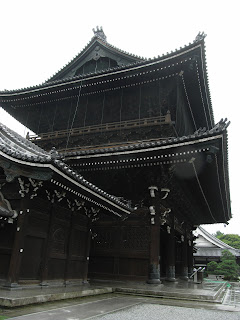First, I visited the Nishinomiya Shell Museum in...I bet you can guess...Nishinomiya! This city of almost half a million people sits between Osaka and Kobe in Osaka Bay. In analogy to the other Bay Area, Nishinomiya is to Kobe as Berkeley is to Oakland. From Nishinomiya, Kobe even looks like Oakland with its bay side container cranes. In what I hope does not become another Berkeley/Oakland similarity, Nishinomiya and Kobe were both devastated in the 1995 Kobe earthquake. Both have since rebuilt and retro-fitted. Did I mention that Nishinomiya has a shell museum!?
 Here I am in the specimen room of the museum, looking for specimens.
Here I am in the specimen room of the museum, looking for specimens. Here are some of the species I analyzed. Oh the diversity!
Here are some of the species I analyzed. Oh the diversity! Next, Osaka. Osaka is one of the largest cities in Japan. It is known for its food, its castle, and (among other things) its recent mention in the Coldplay song, "Lovers in Japan". I am pretty sure, however, that it is not famous for the neighborhood around the Dobutseun-mae subway stop where I spent the night. In the subway map below, you can find it where the brown line intersects the red line. In case you are planning a trip to Osaka in the near future, I would suggest you leave Dobutsuen-mae off your agenda.
 The morning market was pretty interesting though, including lots of pickled, Korean-style vegetables,
The morning market was pretty interesting though, including lots of pickled, Korean-style vegetables,  and the HUGE bivalve, Atrina pectinata.
and the HUGE bivalve, Atrina pectinata. On to Kyoto! Kyoto is very famous for its castle, temples, and shrines. Here is the entrance to the temple, Higashi Honganji.
On to Kyoto! Kyoto is very famous for its castle, temples, and shrines. Here is the entrance to the temple, Higashi Honganji.  Here it is next to the ultra-modern Kyoto Tower.
Here it is next to the ultra-modern Kyoto Tower. This is one of the gardens on the grounds of Nijo Castle.
This is one of the gardens on the grounds of Nijo Castle. The best part of Kyoto for me was Nishiki Market, which sold traditional Japanese food, green tea ice cream, souvenirs, and seafood including molluscs. But alas, no new tsubu gai species.
The best part of Kyoto for me was Nishiki Market, which sold traditional Japanese food, green tea ice cream, souvenirs, and seafood including molluscs. But alas, no new tsubu gai species. And here is that enigmatic raccoon dog again. Apparently it is very popular throughout Japan. I am not yet sure why. (But see below)
And here is that enigmatic raccoon dog again. Apparently it is very popular throughout Japan. I am not yet sure why. (But see below) After a quick internet search (thank you Wikipedia) I discovered that this animal is indeed a raccoon dog that has been depicted in Japanese mythology as a mischievous shape-shifting spirit called a tanuki. More can be found here. And if you are puzzled as I was by the um, "anatomy" below the belly of the tanuki, you would be correct in guessing that it is its "enormous, dragging scrotum." Yup. I am not making that up. You can learn more here.
After a quick internet search (thank you Wikipedia) I discovered that this animal is indeed a raccoon dog that has been depicted in Japanese mythology as a mischievous shape-shifting spirit called a tanuki. More can be found here. And if you are puzzled as I was by the um, "anatomy" below the belly of the tanuki, you would be correct in guessing that it is its "enormous, dragging scrotum." Yup. I am not making that up. You can learn more here. Here are more Kyoto pictures...though no more of giant testicles belonging to beloved spirit-animals.
No comments:
Post a Comment